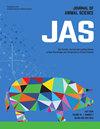Technical Note: Optimizing and Validating an RP-HPLC Method to Determine Lactoferrin in Porcine Colostrum and Milk
IF 2.7
2区 农林科学
Q1 AGRICULTURE, DAIRY & ANIMAL SCIENCE
引用次数: 0
Abstract
This Technical Note provides a detailed description of a sample preparation procedure, along with the validation of a reversed-phase high-performance liquid chromatography (RP-HPLC) method for quantitatively determining lactoferrin (LF) in porcine colostrum and milk. The analysis of native milk samples is a challenging process due to the complex composition of the sample. Raw milk is an emulsion and colloid of fat globules in a water-based liquid containing dissolved carbohydrates and protein aggregates with minerals. This paper aims to optimize a method for preparing porcine colostrum and milk samples, which involves a new combination of homogenization, centrifugation, dilution, and filtration techniques for the subsequent analysis of LF via RP-HPLC. A validation process was implemented to ensure the reliability and repeatability of this analytical approach. The results showed that the quantification of LF content in porcine colostrum (1684.58 ± 466.68 µg/mL; n = 10) and milk (849.75 ± 85.82 µg/mL; n = 10) is feasible with successful validation. In addition, the improved sensitivity due to the novel combination of these preparation steps is shown by low limits of detection and quantification of 0.21 µg/mL each. The advantage of this optimized methodology is that the sample preparation can be carried out relatively simply and using standard laboratory equipment, thus enabling the accurate determination of LF in porcine colostrum and milk samples.技术说明:优化和验证RP-HPLC法测定猪初乳和牛奶中的乳铁蛋白
本技术说明提供了样品制备过程的详细描述,以及用于定量测定猪初乳和牛奶中乳铁蛋白(LF)的反相高效液相色谱(RP-HPLC)方法的验证。由于样品的复杂组成,对本地牛奶样品的分析是一个具有挑战性的过程。原料奶是一种乳液和脂肪球的胶体,在水基液体中含有溶解的碳水化合物和蛋白质以及矿物质。本文旨在优化猪初乳和牛奶样品的制备方法,该方法涉及均质、离心、稀释和过滤技术的新组合,用于随后的RP-HPLC分析LF。实施了验证过程以确保该分析方法的可靠性和可重复性。结果表明:猪初乳中LF含量定量为(1684.58±466.68µg/mL;n = 10)和牛奶(849.75±85.82µg/mL;N = 10)是可行的,且验证成功。此外,由于这些制备步骤的新颖组合,灵敏度得到了提高,每个步骤的检测限和定量限均为0.21µg/mL。该优化方法的优点是样品制备相对简单,使用标准的实验室设备,可以准确测定猪初乳和牛奶样品中的LF。
本文章由计算机程序翻译,如有差异,请以英文原文为准。
求助全文
约1分钟内获得全文
求助全文
来源期刊

Journal of animal science
农林科学-奶制品与动物科学
CiteScore
4.80
自引率
12.10%
发文量
1589
审稿时长
3 months
期刊介绍:
The Journal of Animal Science (JAS) is the premier journal for animal science and serves as the leading source of new knowledge and perspective in this area. JAS publishes more than 500 fully reviewed research articles, invited reviews, technical notes, and letters to the editor each year.
Articles published in JAS encompass a broad range of research topics in animal production and fundamental aspects of genetics, nutrition, physiology, and preparation and utilization of animal products. Articles typically report research with beef cattle, companion animals, goats, horses, pigs, and sheep; however, studies involving other farm animals, aquatic and wildlife species, and laboratory animal species that address fundamental questions related to livestock and companion animal biology will be considered for publication.
 求助内容:
求助内容: 应助结果提醒方式:
应助结果提醒方式:


